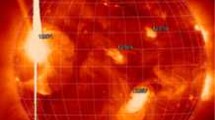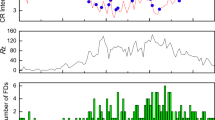Abstract
A detailed study has been conducted on the long-term changes in the diurnal variation of cosmic rays in terms of high and low amplitude wave trains event (HAEs/LAEs) during the period 1996–2008 (solar cycle 23), using the neutron monitor data from Kiel neutron monitoring station. As such, 17 HAE and 48 LAE cases have been detected and analyzed. These HAEs appear quite dominantly during the declining phase as well as near the maximum of the solar activity cycle 23. In contrast, the low amplitude events (LAEs) are inversely correlated with solar activity cycle. In fact, LAEs appear quite dominantly during the minimum phase of the solar activity. When we compare our results for diurnal phase with that observed on an annual average basis, we notice no significant diurnal phase shift for HAEs as well as for LAEs. Moreover, we find that the high-speed solar wind streams (HSSWS) do not play any significant role in causing these variations. These results are discussed on the basis of that observed in earlier cycles.
Similar content being viewed by others
References
Agrawal, S. P., Bercovitch, M. 1983, Study of 11, 22-year periodic variation of cosmic ray diurnal anisotropy, Proc. 18th Int. Cosmic Ray Conf., Bangalore (India), 3, 316–319.
Ananth, A. G., Agrawal, S. P., Rao, U. R. 1974, Study of cosmic ray diurnal variation on a day-to-day basis, Pramana, 3, 74–88.
Ananth, A. G., Kudela, K., Venkatesan, D. 1995, Characteristics of enhanced low-amplitude cosmic ray diurnal variation, Solar Phys., 159, 191–202.
Fluckiger, E. O. 1991, Solar and terrestrial modulation, Proc. 22nd Int. Cosmic Ray Conf., Dublin, 5, 273.
Hashim, A., Thambyahpillai, T. 1969, Large amplitude wave trains in the cosmic ray intensity, Planet. Space Sci. (France), 17, 1879.
Iucci, N., Parisi, M., Storini, M., Villoresi, G. 1981, Proc. 17th Int. Cosmic Ray Conf., Paris (France), 10, 238.
Kane, R. P. 1975, A study of days showing non-field-aligned diffusion vectors of cosmic ray diurnal anisotropy, J. Geophys. Res., 80, 3509–3518.
Kane, R. P. 2009, High amplitude anisotropic events (HAE) in cosmic ray diurnal variation during solar cycle 23, Indian J. Radio & Space Phys., 38, 189–196.
Kumar, S., Chauhan, M. L. 1996, Unusually low amplitude anisotropic wavetrain events in cosmic ray intensity, Indian J. Radio & Space Phys., 25, 106.
Kumar, S., Chauhan, M. L., Dubey, S. K. 1997, Effect of interplanetary turbulences causing high/low amplitude anisotropic wave trains in CR intensity, Solar Phys. (Netherlands), 176, 403.
Mishra, R. K., Mishra, R. A. 2007, Long-term variation of cosmic ray anisotropy during high amplitude days, Indian J. Radio & Space Phys., 36, 9.
Mishra, R. K., Mishra, R. A. 2008, Solar cycle dependence of low amplitude anisotropic wave train events, Indian J. Radio & Space Phys., 37, 312–318.
Munakata, K., Mori, S., Ryu, J. Y., Agrawal, S. P., Venkatesan, D. 1987, High-speed solar wind stream and modulation of cosmic ray anisotropy, Proc 20th Int. Cosmic Ray Conf., Moscow (USSR), 4, 39–42.
Parker, E. N. 1991, The magnetic field of the galaxy, Proc. 22nd Int. Cosmic Ray Conf., Dublin, 5, 35–47.
Rao, U. R., Ananth, A. G., Agrawal, S. P. 1972, Characteristics of quiet as well as enhanced diurnal anisotropy of cosmic radiation, Planet. Space Sci., 20, 1799–1816.
Riker, J. F., Ahluwalia, H. S. 1987, A survey of the cosmic ray diurnal variation during 1973–79. 2. Application of diffusion-convection model to diurnal anisotropy data, Planet. Space Sci., 35, 1117–1122.
Singh, Munendra, Badruddin 2006, Study of the cosmic ray diurnal anisotropy during different solar magnetic conditions, Solar Phys., 233, 291–317.
Author information
Authors and Affiliations
Corresponding author
Rights and permissions
About this article
Cite this article
Singh, A., Tiwari, A.K. & Agrawal, S.P. Study of high and low amplitude wave trains of cosmic ray diurnal variation during solar cycle 23. J Astrophys Astron 31, 89–96 (2010). https://doi.org/10.1007/s12036-010-0007-8
Received:
Accepted:
Published:
Issue Date:
DOI: https://doi.org/10.1007/s12036-010-0007-8




